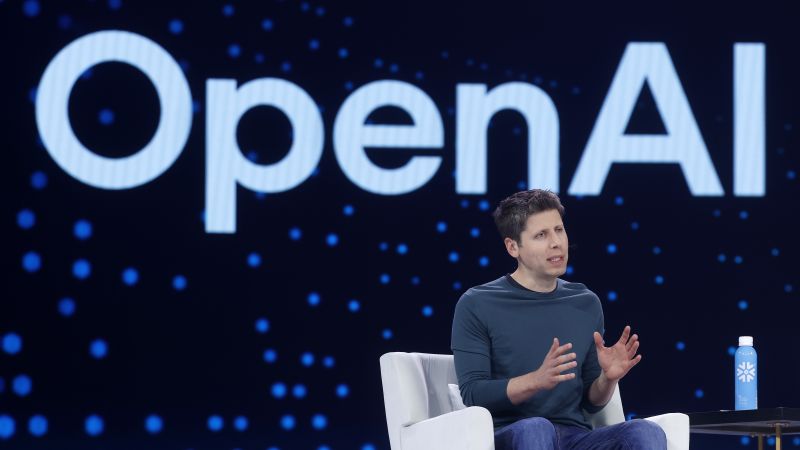
A version of this story appeared in CNN Business’ Nightcap newsletter. To get it in your inbox, sign up for free here.
Every time I think there can’t possibly be another way for a big tech company to intertwine its fate with that of OpenAI, the tech titans manage to turn the industry into even more of a rat’s nest.
See here: On Monday, Nvidia announced a $100 billion investment in OpenAI, the privately owned maker of ChatGPT. The idea is that Nvidia gives OpenAI cash to build data centers, and in return, OpenAI buys Nvidia’s chips (at a discount) to power those data centers. In short: OpenAI gets some much-needed cash and Nvidia secures demand for its chips.
OpenAI “is now too big to fail for the sake of the (generative AI) data center buildout,” wrote Peter Boockvar, chief investment officer of wealth management firm OnePoint BFG Wealth Partners, in a note Tuesday. “For this whole massive experiment to work without causing large losses, OpenAI and its peers now have got to generate huge revenues and profits to pay for all the obligations they are signing up for and at the same time provide a return to its investors.”
For now, there’s a lot we don’t know about the Nvidia-OpenAI agreement, which so far exists only as a letter of intent. We don’t know the time frame for the investment, for one. And it is unclear how OpenAI, which has never turned a profit and brings in only about $13 billion a year in revenue, would actually, like, pay for any of it.
Per Reuters’ Stephen Nellis: Even with Nvidia’s cash, OpenAI would need an additional $40 billion for each gigawatt of capacity it plans to build (and in the end, it plans to build 10 gigawatts of computing power — roughly the equivalent of powering 8 million homes).
Where does that extra money come from?
OpenAI, which didn’t respond to a request for comment, is burning through cash at a rate that would make even Silicon Valley’s most bullish AI bro choke on his matcha latte. The Information recently reported that the company’s projected cash burn for this year through 2029 will hit $115 billion — about $80 billion higher than OpenAI previously expected.
Oh, and OpenAI is also locked into agreements to spend billions buying chips and renting data center capacity from other companies including Broadcom and Oracle.
Let’s zoom out.
The AI industry is so incestuous we’d need a flow chart to explain all of the overlapping commitments that have been hashed out between a handful of companies. (One Bluesky user has made that chart a reality, if anyone’s curious.)
In industry lingo, this is called “circularity.” Nvidia gives cash to OpenAI; OpenAI uses cash to buy chips from Nvidia. Amazon invests $4 billion in Anthropic; Anthropic spends $4 billion on Amazon Web Services.
“Such circular arrangements are common in the AI world and have raised questions about the extent to which new sales reflect genuine market demand versus capital recycled within the industry,” write WSJ’s Berber Jin and Robbie Whelan.
On the bright side, that circular nature means the risks are somewhat concentrated. On the not-so-bright side, they are concentrated in an industry that has, for better or worse, been propping up the American economy for about a year.
“In the absence of tech-related spending, the US would be close to, or in, recession this year,” wrote George Saravelos, global head of FX research at Deutsche Bank, in a note Tuesday.
“It may not be an exaggeration,” he added, to say that Nvidia alone “is currently carrying the weight of US economic growth.”
The problem with that, Saravelos writes, is that if tech spending is going to keep propping up the economy, the “capital investment needs to remain parabolic.” That’s highly unlikely to happen, he argues, citing research suggesting capital expenditure growth among so-called hyperscalers like Microsoft, Amazon and Google is peaking this year.
Which brings us back to the central problem from earlier: Where will the money come from?
Selling ChatGPT
Here’s where regular shmoes like you and me come in.
OpenAI and its investors are betting on the prospect that we will become so reliant on ChatGPT, we’ll actually want to pay for it.
Now, ChatGPT is a wildly popular app, to be sure, having gained more than 700 million users over the past three years, according to OpenAI. But the company has to keep signing people up. Then it has to persuade a bunch of them to pay for the premium tier, which, just like the free version, has demonstrated limited practical applications and has a tendency to drag some people into delusional, at times deadly, spirals.
It’s not clear how OpenAI plans to do that.
For the past three years, the company has been promising ever-more magical versions of ChatGPT. But OpenAI’s spell on the tech world began to falter over the summer with its release of ChatGPT-5, which CEO Sam Altman had likened to summoning a “PhD-level expert” on virtually any subject.
The launch was a disaster — users hated the new bot, which generated inaccurate results and appeared unable to replicate some of the tasks that earlier versions could execute. OpenAI appeared befuddled at the bad reception and promised to make changes.
And to be sure, the whole “give it away for next to nothing” strategy is a classic Silicon Valley move that can work. Consider Uber, which operated at a loss for years as it hooked users with cheap rides that drastically undercut the taxi industry (while also flagrantly flouting local labor laws that it had to spend years and billions of dollars dealing with in court … but that’s another story).
The question is: Is ChatGPT so uniquely useful that you’d pay a premium to use it over any number of free chatbots on the market, like the one that already shows up at the top of your Google search page, for instance?
For most people, the answer is almost certainly no. For businesses, the answer is … murky at best. Corporate America would force workers to adopt any technology that could meaningfully improve the bottom line, but so far that just isn’t happening, according to recent studies from MIT and McKinsey. Despite tech industry promises, most companies that have rolled out AI tools saw no impact on revenue.
So once again, I shout into the void: Where will the money come from?



